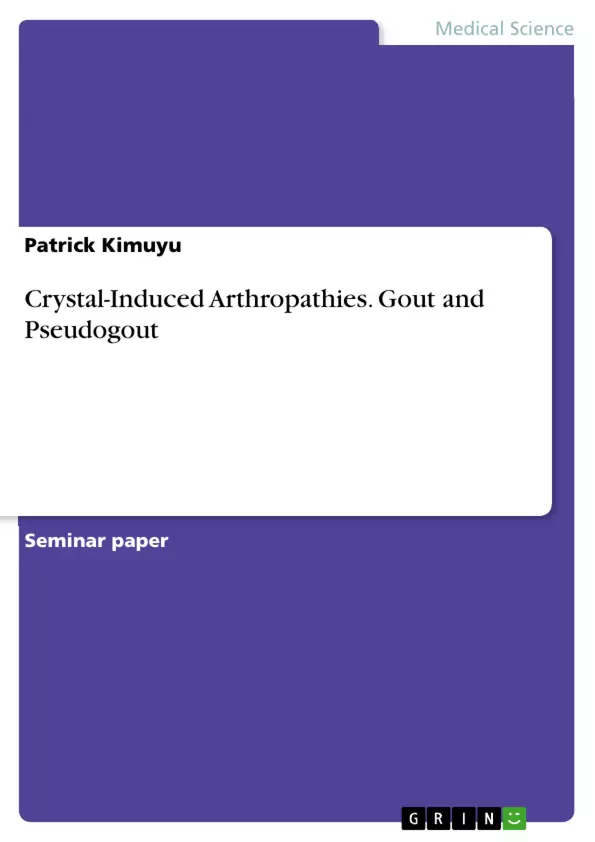Gout and pseudogout are believed to the most prevalent crystal-induced arthropathies in humans. These disorders occur due to the deposition of crystals in the joints and soft tissues. This results into periarticular and articular inflammation and injury. Some of the most common crystals that are responsible for arthropathies such as gout and pseudogout include hydroxyapatite, monosodium urate (MSU), calcium oxalate and calcium pyrophosphate dehydrate (CPPD) (Rothschild, 2014). In practice, gout and pseudogout are relatively different despite the fact that they are crystal-induced arthropathies, and their difference can be explained by their definitions. Gout is defined as a crystal deposition disease that is characterized by the precipitation and super-saturation of monosodium urate (MSU) in tissues. This deposition of monosodium urate crystals causes inflammation of the joints and soft tissues, and this is attributable to tissue damage. Therefore, gout is characterized by sub-acute or acute attacks of joints or the inflammation of soft tissues resulting from the deposition of monosodium urate. The clinical course of gout involves an underlying metabolic aberrancy referred to as hyperuricemia which is defined as the serum urate level of more than 6.8 mg/dL (Al-Ashkar, 2010). On the other hand, pseudogout is defined as a clinical syndrome that resembles gout, and it is caused by the deposition of calcium pyrophosphate dehydrate crystals in soft tissues and joints, resulting into the inflammation and cartilage tissue damage. Therefore, the term pseudogout emanates from the nature of its clinical presentation in which acute attacks of the joints resembles those observed in gout (Al-Ashkar, 2010). However, it is worth noting that, in pseudogout, chondrocalcinosis is the most distinctive feature for the syndrome although some patients with chondrocalcinosis do not present with pseudogout. This seminar paper focuses on gout and pseudogout.
Inhaltsverzeichnis (Table of Contents)
- Introduction
- Epidemiology of Gout and Pseudogout
- Pathophysiology
- Clinical Presentation
- Diagnosis and Differential Diagnosis of Gout and Pseudogout
- Diagnostics for Gout and Pseudogout
- Treatment/Management
- Conclusion
Zielsetzung und Themenschwerpunkte (Objectives and Key Themes)
This text aims to provide a comprehensive overview of crystal-induced arthropathies, specifically gout and pseudogout. It delves into the epidemiology, pathophysiology, clinical presentation, diagnosis, and treatment of these conditions.
- The epidemiology of gout and pseudogout, including global prevalence rates and demographic variations
- The metabolic processes involved in the formation of monosodium urate and calcium pyrophosphate dehydrate crystals
- The clinical presentation of gout and pseudogout, including the characteristic symptoms and signs
- The diagnostic approaches used to differentiate gout and pseudogout from other conditions
- The treatment and management options for both gout and pseudogout
Zusammenfassung der Kapitel (Chapter Summaries)
- Introduction: This chapter introduces the concepts of gout and pseudogout as crystal-induced arthropathies, highlighting their prevalence and the role of various crystals in their development.
- Epidemiology of Gout and Pseudogout: This chapter examines the global distribution and prevalence of gout and pseudogout, exploring demographic variations and contributing factors such as diet, environment, and genetics. It also provides specific data on prevalence rates in various countries, including the UK, Italy, and the US.
- Pathophysiology: This chapter focuses on the physiological processes underlying gout, emphasizing the role of uric acid metabolism, hyperuricemia, and the formation of monosodium urate crystals within the joints and soft tissues.
Schlüsselwörter (Keywords)
The text focuses on crystal-induced arthropathies, particularly gout and pseudogout. Key terms and concepts include monosodium urate (MSU), calcium pyrophosphate dehydrate (CPPD), hyperuricemia, urate crystals, tophi, clinical presentation, diagnosis, and treatment.
- Arbeit zitieren
- Patrick Kimuyu (Autor:in), 2018, Crystal-Induced Arthropathies. Gout and Pseudogout, München, GRIN Verlag, https://www.grin.com/document/388326



